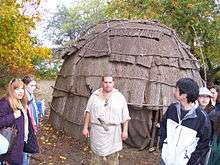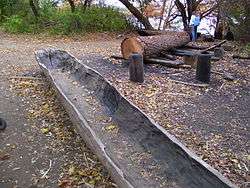Plimoth Plantation
Plimoth Plantation, founded in 1947, is a living history museum in Plymouth, Massachusetts, USA that exhibits the original settlement of the Plymouth Colony established in the 17th century by English colonists, some of whom later became known as Pilgrims. They were among the first people who emigrated to America to seek religious separation from the Church of England.[1] It is a not-for-profit museum supported by Administrations, contributions, grants, and volunteers.[2]
The re-creations are based upon a wide variety of first-hand and second-hand records, accounts, articles, and period paintings and artifacts,[3] and the museum conducts ongoing research and scholarship, including historical archaeological excavation and curation locally and abroad.[4]
In the 1627 English Village section of the museum, "first-person" interpreters have been trained to speak, act, and dress appropriately for the period, whereas "third-person" or "modern" interpreters have been trained to answer inquiries guests may have that those in character are unable to answer while in their respective roles. [5] At Plimoth Plantation, they are called historical interpreters, and they interact with their 'strange visitors' (i.e., the modern general public) in the first person, answering questions, discussing their lives and viewpoints, and participating in tasks such as cooking, planting, blacksmithing, and animal husbandry.[6] The 1627 English Village loosely follows a time line, chronologically representing the calendar year 1627 from late March through November (the months when the museum is open),[7] depicting day-to-day life and seasonal activities, as well as featuring some key historical events, such as funerals and special celebrations.
History
Telling the iconic story of Plymouth Colony was the fulfillment of a young archaeologist’s boyhood dream. Henry Hornblower II started the Museum in 1947 with help and support from friends, family, and business associates, as two English cottages and a fort on Plymouth’s historic waterfront. Since then, the Museum has grown to include Mayflower II (1957), the English Village (1959), the Wampanoag Homesite (1973), the Hornblower Visitor Center (1987), the Craft Center (1992), the Maxwell and Nye Barns (1994), and the Plimoth Grist Mill (2013)[8]
Other attractions
Alongside the settlement is a re-creation of a Wampanoag home site, where modern Native People from a variety of nations (not in period character, but in traditional dress) explain and demonstrate how the Wampanoag's ancestors lived and interacted with the settlers.
The museum grounds at Plimoth Plantation also include Nye Barn, where historical breeds of livestock are kept, a crafts center where many of the objects used in the village exhibits are created, a cinema where educational videos are shown, a Colonial Education site for youth and adult groups, and visitors' center with indoor exhibits and educational programs. The two houses on the Colonial Education site were built by Plimoth Plantation for the PBS show Colonial House filmed in Maine. Following the filming, the museum disassembled the houses and reconstructed them at Plimoth Plantation.[9] The roof of one of these houses, the Cook House, was destroyed by a fire from a fireplace on November 19, 2011. The building had to be torn down.[10]
Mayflower II, docked near the purported Plymouth Rock, is also under the care of the museum. Colonial first-person interpreters represent the sailors and officers of the ship circa the 1620s. At some times, the "sailors" go on week-long trips to experience what it was like for Pilgrims.[11]
See also
- Plymouth Colony, history of the Plymouth settlement in North America from 1620 - 1691
- Plantation (settlement or colony)
- Open-air museum
Images
 Wigwam and Wampanoag guide
Wigwam and Wampanoag guide Native American canoe building
Native American canoe building Entrance, with blacksmith shop on the right
Entrance, with blacksmith shop on the right Blacksmith
Blacksmith Mary Soule, wife of George Soule
Mary Soule, wife of George Soule House
House Livestock
Livestock Recreated fort also served as First Parish Church in Plymouth and a colony meeting house, originally on Burial Hill
Recreated fort also served as First Parish Church in Plymouth and a colony meeting house, originally on Burial Hill View from the fort, looking down a recreation of Leyden Street, the first street in Plymouth
View from the fort, looking down a recreation of Leyden Street, the first street in Plymouth Dr. John Kemp, director of the Colonial Interpretation Department, portraying Samuel Fuller (Mayflower physician) at the church
Dr. John Kemp, director of the Colonial Interpretation Department, portraying Samuel Fuller (Mayflower physician) at the church Fort originally on Burial Hill, coming up Leyden Street
Fort originally on Burial Hill, coming up Leyden Street Pilgrim George Soule house
Pilgrim George Soule house
Notes
- ↑ Plymouth Ma - Its History And People
- ↑ About Plimoth Plantation
- ↑ Behind the Scenes articles
- ↑ Colonial Archeology at Plimoth Plantation
- ↑ Glossary: First-Person Interpretation
- ↑ 1627 English Village FAQs
- ↑ Plan Your Visit to Plimoth Plantation
- ↑ http://www.plimoth.org/about-us
- ↑ The Colonial Educational Site at Plimoth Plantation in Plymouth Massachusetts
- ↑ The Boston Globe (November 20, 2011). Fire ruins Plimoth Plantation house.
- ↑ Mayflower II
External links
- Plimoth Plantation
- "Writings of William Bradford" from C-SPAN's American Writers: A Journey Through History, broadcast from Plimoth Plantation, March 19, 2001
Coordinates: 41°56′20.64″N 70°37′33.69″W / 41.9390667°N 70.6260250°W